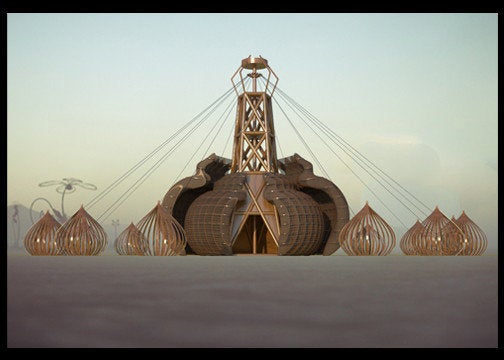
Each year around 50,000 people come together at Burning Man, the now-infamous outdoor event in the northern Nevadan desert. Needless to say, the artwork produced is radically innovative, complex and a little wacky. We recently saw the "Singular Transmissons" project on Kickstarter and were intrigued, so we asked the team of 21 artists involved more about their innovative project. Scroll down for the interview.
"Singularity Transmissions" is a 40-foot sculptural interactive tower that resembles a flower pistil -- an homage to Burning Man's theme this year: Fertility 2.0. People can sing, scream, or make any other possible sound into tin can phones, which will be set up in 15 locations around the base. The voices will be digitally recorded and then projected in a listening chamber at the sculpture's base. These noises and silences will layer upon each other to echo the sounds of Burning Man. At the culmination of the festival, the tower will be burned down, but the audio and the memories will remain. We asked lead artist Troy Stanley about the project's goals and process.
HP: You describe your team as a crew of rugrats, misfits and dreamers. How did you all come together for this project?
TS: A piece as complicated as this requires experts from fields that would, under 'normal' circumstances, rarely work together. We needed wood workers, architectural engineers, welders, audio engineers, lighting techs, and many other specific skill sets to just create the sculpture, but having to build at Black Rock Desert also makes it necessary that our team include survivalists, a kitchen crew, and Burning Man veterans who have worked under these conditions before. To bring these people together and have them coalesce into a great team really took a unified vision, and thankfully the sculpture itself served as that vision. I think that has been the key all along and why everyone of us is putting our all into the project. We kind of became our own singularity.
HP: What does the shape of the piece say about the relationship between nature and technology?
TS: Growing up in this generation and being able to see the influx that technology has had on our lives places many of us at odds with what we do and what we think. We know that with everything there is two sides, technology has given us the ability to do so much, but often at the expense of nature and the environment. For this project we were really trying to portray something that is less apparent, often subtle, and unnoticed. It is that space between nature and technology that each can exist in a sort of harmony. Its like a vine growing up a power line cable, or a spider stringing its web near a neon sign. We wanted a flower with outstretched petals embracing a transmission tower. A dichotomy with the rigid geometry of the structure and the fluid organic poetics of a pistil coming together and becoming one and the same. Our hope was that this all encompassing symbolic embrace can foster a fertility of ideas; perhaps even ideas where technology and nature can find a balance and lead us into a more harmonious future.
HP: Why did you decide to burn down the sculpture at the end of the festival?
TS: To make what remains that much more significant. While we are burning down the piece at the end of the festival, all the collected audio will be available online in an open source data base. We're combining old and new technology (tin can phones, hard drives, mixers, etc.) to create a new kind of time capsule -- one that would not have been technically or financially possible in the past. There will be a 'best of' album, but ALL will be accessible to the public. That's 15 channels of audio, 24 hours, for 7 days! Whether this audio is used as-is or remixed as desired, our hope is for artist, musicians, film makers, and performers to create new work with this material. Showing that while the physical is fleeting, inspiration only grows.
HP: What can the 'real world' learn from Burning Man?
TS: There are many things that the 'real world' can learn from Burning Man. Their '10 Principles' (rules to live by while at the event) include things that we could all benefit from. Principles like radical self reliance, civic responsibility, radical inclusion, and decommodification. From a purely artistic perspective I think we can learn the value of the inherent human spirit. Black Rock Desert is a 400 square mile expanse of nothing, meaning it can be turned into ANYTHING. It's a beautiful thing. The size and scope of some of the pieces are daunting. At 40-ft tall and a 90-ft diameter, “Singularity Transmissions” is still one of the smaller structures out there. The old cliche, "If you can dream it, you can do it" was never more true than at Burning Man. You just have to be willing to work harder than you knew you were even capable of, and that's when those dreams become reality.
At the end of festival every participant realizes that we all were just visiting. The citizens and teams of Burning Man return the Playa back to the way it was when they first set foot on the dusty ground. An all volunteer army of people take personal responsibility to make sure that we preserve that which matters most. I think there is something beautiful to learn from that.
Visit "Singular Transmissions" on Kickstarter to see how you can help.